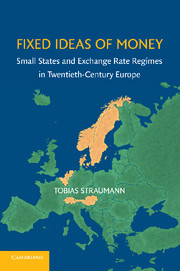Book contents
Six - Hard and Soft Pegs
Published online by Cambridge University Press: 06 July 2010
Summary
It was shown in Chapter FIVE that the small European states preferred to have pegged exchange rates during the 1970s and 1980s and that Switzerland's shift to a floating regime in 1973 was viewed as an exception confirming the rule, not as a new model. Yet, although small states shared this common approach, the strength of their currencies and the type of exchange-rate pegs they used diverged, starting with the Frankfurt realignment in October 1976. Three groups can be distinguished (Figures 6.1 and 6.2):
Austria and the Netherlands maintained a hard peg to the deutsche mark (DM) with only minor changes – Austria independently and the Netherlands as a member of the Snake and the European Monetary System (EMS).
Belgium and Denmark participated in the Snake and the EMS, but made several devaluations until 1982. From then on, both currencies maintained a hard peg against the DM.
Sweden and Norway devalued their currencies several times within the Snake and then left the Snake and adopted a currency basket peg in 1977–1978. After changing the peg, Sweden undertook three devaluations, among them a “big bang” devaluation in 1982 (by 16 percent). The Norwegian krone, by contrast, remained a stable currency from 1979 on, with the exception of a one-time devaluation in 1986.
How can we explain these different trajectories? As in Chapter FIVE, I propose to divide the numerous explanations into two groups, one based on domestic institutions and policy preferences and one based on external factors.
- Type
- Chapter
- Information
- Fixed Ideas of MoneySmall States and Exchange Rate Regimes in Twentieth-Century Europe, pp. 214 - 275Publisher: Cambridge University PressPrint publication year: 2010



